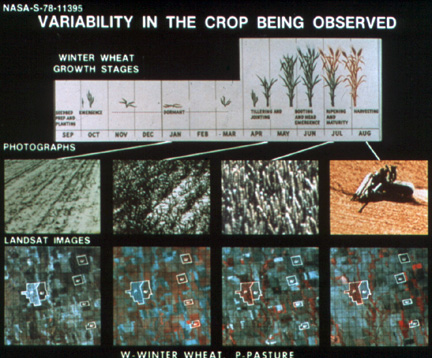
These spectral variations facilitate fairly precise detection, identification and monitoring of vegetative matter on the Earth's land surface and, in some instances, within the oceans and other water bodies. Thus, changes in forests, grasslands and range, shrublands, crops and orchards, and marine plankton can be continually assessed, often at quantitative levels. Since vegetative organic substances are dominant components in most ecosystems, valuable information suited to characterization and management of these systems is now routinely gathered by remote sensors operating from space.
One of the most successful applications of multispectral space imagery lies in its ability to monitor the state of the world's agricultural production. This includes the capability of identifying and differentiating most of the major crop types: wheat, barley, millet, oats, corn, soybeans, rice, and others. This in itself offers an opportunity to quantitatively assess on a global scale the total acreage dedicated to these and other crops at any given time. Of greater import, it is possible to estimate accuracy in best cases to 90% or better for the expected yields (production in bushels or other units) of each crop, either locally or regionally or worldwide, by first knowing the relative areas dedicated to each and then incorporating reliable assessments of yields per unit area gathered by agronomists at representative ground truth sites. Such reliability is enhanced by the repeat coverage of the same "real estate" afforded by the cyclic orbits of the satellites (assuming, of course, cloud cover is sparse enough to foster several "good looks" during the growing season). Usually, the yield estimates obtained from satellite data are both more comprehensive and earlier (often by weeks) than determined conventionally as harvesting approaches. Information about soil moisture content, often critical to good production, can be qualitatively (and under favorably conditions, quantitatively) appraised with certain satellite observations. Under suitable circumstances, crop stress (generally, from moisture deficiency) or disease can be detected and sometimes treated effectively before the farmers become aware of problems. Satellite observations have even been claimed to be successful in some instances in detecting drug-supplying crops such as poppies and wild tobacco (marijuana).
Crop discrimination rests on several characteristics of the plants involved. Considering vegetation in general, deciduous leaves tend to be more reflective than evergreens. Thus, in infrared color composites, the reds associated with those bands in the 0.7 - 1.1 µm intervals will normally be richer in hue and brighter from leaves in trees like maples than from needles on trees like pines. But, of greater import are such parameters as the size and shape of the overall crop type (soybeans, with spread out clumps; corn, with tall stalks; thin, tassled stems and small leaves like wheat), the shape and surface area of individual leaves, the height of the plant and amount of shadow it casts, and the spacing or other planting geometries of row crops (the normal arrangement of legumes, feed crops, and fruit orchards). The stage of growth - degree of maturity - is also a factor: during its developmental history wheat, for example, passes through several distinct steps in its size and shape including development of its kernel-bearing head, and changes from shades of green to golden-brown.
These stages can be followed in this sequential illustration:

Note that, in the Landsat imagery, the wheat fields show their brightest response in the IR (hence red) during the emergent stage but become less responsive by the ripening stage. The grasses and alfalfa that make up pasture crops mature (redden) much later.
In addition, the crop's background, namely the nurturing soil (which may variegate in color and other properties) and the amount of moisture it holds, will vary from place to place over time. All of these factors combine to bring about small to large differences in spectral signatures for the many varieties of crops cultivated by man. Generally, the signatures for different crops in a particular region must be determined from representative samples at specific times, although some crop types have universally similar spectral responses at equivalent growth stages.
Code 935, Goddard Space Flight Center, NASA
Written by: Nicholas M. Short, Sr. email: nmshort@epix.net
and
Jon Robinson email: Jon.W.Robinson.1@gsfc.nasa.gov
Webmaster: Bill Dickinson Jr. email: rstwebmaster@gsti.com
Web Production: Christiane Robinson, Terri Ho and Nannette Fekete
Updated: 1999.03.15.